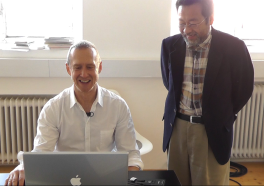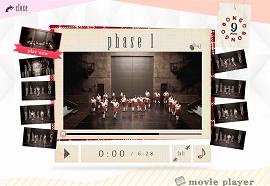
1994年、フォーサイスのフランクフルト・バレエ団の芸術監督就任10周年を祝うために、カールスルーエにあるメディア・テクノロジー・センター(ZKM)と共同制作された『インプロヴィゼーション・テクノロジーズ』は、当時最新のメディア・テクノロジーを駆使し、インタラクティブに独習できるように、彼の特異なダンス・ヴォキャブラリーを採集・編集した「動きの辞書」のようなものでした。
その後、オハイオ州立大学と共に制作されたのが『シンクロナス・オブジェクツ』です。これは彼の代表的な作品『One Flat Thing, reproduced(通称:テーブル・ダンス)』を分析し、データ化し、図像化したもので、身体的な思考が自由にイラストレーション化される実例が満載されています。このプロジェクトはウェブサイトにて無料で自由にアクセス可能です。
http://synchronousobjects.osu.edu/
今回ご紹介するBongo Bongoは、彼の作品を実際に踊ってみようという趣旨のメイキングプロジェクトです。上記のように辞書があり、作品分析があるのだから、そろそろ大胆にも彼の作品を踊ってみようという意図から生まれました。
日本女子体育大学ダンス・プロデュース研究部は、すでにこのBongo Bongoを映像を見ながら自分たちで振り写して踊っていました。2011年、東京ドイツ文化センターと慶應義塾アートセンターの共催による「身体のイラストレーション」というワークショップ&シンポジウムが行われた際、このメイキングをウェブサイトに掲載し、誰でも無料でアクセスできるようにしようという案が具体化し、実現しました。
このダンス作品はミッションスクール・ガール・ダンスとも言われ、女子制服を着たダンサー(本来は男性も女装する)が動きを繰り返し、最後は大団円となって踊る、盆踊りのような楽しさがあります。しかし、実は振付自体は難しいため、踊る側はもっとシンプルに自由にアレンジして構いません。フォーサイスも皆が自由に踊って楽しんでくれるのが一番良いと言っています。


Project Outline

In 1994, to celebrate the 10th anniversary of Forsythe’s appointment as Artistic Director of the Frankfurt Ballet, “Improvisation Technologies” was co-produced with the ZKM Center for Art and Media in Karlsruhe. Utilizing the latest media technology of the time, it was created as a “dictionary of movements” that collected and edited his unique dance vocabulary, allowing for interactive self-study.
Following this, “Synchronous Objects” was produced in collaboration with Ohio State University. This project analyzed, digitized, and visualized his representative work “One Flat Thing, reproduced” (commonly known as the table dance), providing numerous examples of how physical thinking can be freely illustrated. This project is freely accessible on their website.
http://synchronousobjects.osu.edu/
The project we are introducing today, Bongo Bongo, is a making-of project with the intention of actually dancing his works. Given the existence of a dictionary and work analysis, the idea was born to boldly dance his works.
The Dance Production Research Club at Japan Women’s College of Physical Education had already been watching videos of Bongo Bongo and replicating the choreography. In 2011, during the “Illustration of the Body” workshop and symposium co-hosted by the Goethe-Institut Tokyo and the Keio University Art Center, the idea was proposed to upload this making-of project to the website for free access by anyone, which eventually came to fruition.
This dance piece, also known as the Mission School Girl Dance, features dancers in school uniforms (originally men dressed as women) repeating movements and culminating in a grand finale, reminiscent of a bon dance, making it fun for everyone to dance. However, the choreography itself is actually difficult. Performers are encouraged to simplify and freely arrange the movements. Forsythe himself has said that it is best when everyone dances freely and enjoys it.
